The time has come! It’s one of the busiest (and most adorable) times of the year on our farm! We have 60 ewes used for breeding that are on pasture from May to October, and then we bring them in to our pens as the weather gets colder and patiently wait for the babies to arrive. And here some of them are!
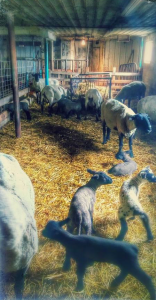
We took on a pretty big project this year. We have an old dairy barn on our farm that hasn’t been used, so this summer we stripped the barn, tore out all the old equipment, and built all new sheep pens out of wood. Our lambs can now be born indoors to protect them from predators and weather elements and to allow us to give them better care with less labor. There’s automatic waterers and versatility with space, bedding, and feed. We even built our own homemade feed troughs and hay feeders like this here:
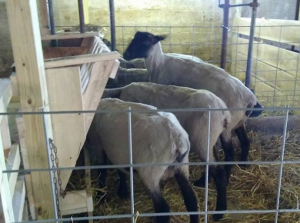
Over half of our ewes have given birth so far this year. Our breed of sheep cycle in the fall, so we turn the rams out to pasture with them around September or October, and with a five-month gestation, their time has come! We have two rams for 60 ewes.
Here are some of our pregnant girls who are due any day now:
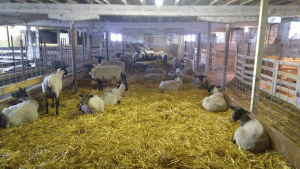
After a ewe gives birth, she is put in an individual maternity pen called a “jug,” where her and her lamb(s) will bond. This helps them get to know each other’s scent, and here we can monitor the health of each lamb separately — making sure mom is producing enough milk from her udder to feed them and make sure the health of the newborn lambs is going well. The mother ewe will lick their lambs to dry them off, and it is a lamb’s instinct to get up and find the udder for their first drink of colostrum. It is really neat to see nature and instinct in action. Here is one of our mama ewes with her newborn triplets. Most ewes should have twins, but singles are also quite common; occasionally they’ll have triplets or, at rare times, even more!
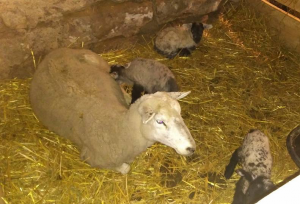
Sometimes not everything goes smoothly. Sometimes a lamb doesn’t come out alive, sometimes health problems occur, sometimes a mom doesn’t give enough milk, sometimes the ewe will neglect their young. It’s just like people, some moms are better than others; sometimes medical complications happen which are out of their control.
One example of this is a ewe we had who was very old. She didn’t lick them off, she didn’t care for them, she no longer produced milk. When I found her twins, we had to take action into our own hands, wipe off the lambs, dry them off, warm them up, and give them a bottle. These are what we now call “orphan lambs.” This ewe will have to be put down this year … she’s just old, and no animal lives forever. Her time has come, and one of her lambs was too weak and didn’t make it. The other one is doing well though, with a set of twins who’s ewe couldn’t produce enough milk so they are together in a pen. The room is heated and they have a bucket feeding system where they can nurse on nipples on a bucket full of milk replacer whenever they are hungry. Plus, they have us for bottles and snuggles. Bottle babies are always the most friendly.
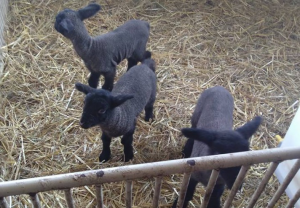
Did you know sheep are born with long tails? Bet most people have never seen a long tailed sheep before! Sheep can get common diseases under their tails, so it has always been proper husbandry to band them. A small band is placed around the tail when they are 3 to 5 days of age, and as they grow, the long tail will eventually fall off. This is also done for male castration. This is the most humane way of doing this — historically people have used a special knife or ax! They are also vaccinated at this time. Just like us or our pets, getting them “fixed” or having to follow proper medical husbandry, get vaccines, etc. … it is very important to their health.
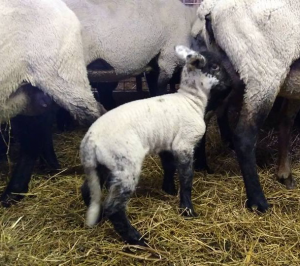
After this, ewes and their lambs will slowly start to be introduced to one another. We will put ewes in groups of two, three, five, whatever. Eventually they will be introduced to bigger and bigger groups (like shown above) until the entire herd is together with their lambs, too. Here we move them all into a bigger pen outside, slowly introduce lambs to solid food called “creep feed,” and eventually they will be weaned off mom around 60 days of age. When the ewes go back out to grassy pasture for breeding again during better weather, the lambs are fed grass, grain, and hay before they are ready to go to market at about 160 pounds for the type of breed we raise. I think when some people think of lamb chops, they think of tiny babies, but they actually look more like grown sheep when they go to market.
So if you enjoy lamb chops or any other type of lamb dish, now you’ll have a better idea of the work involved from getting it from farm to fork!
Michelle Miller, the Farm Babe, is an Iowa-based farmer, public speaker and writer, who lives and works with her boyfriend on their farm which consists of row crops, beef cattle, and sheep. She believes education is key in bridging the gap between farmers and consumers.



